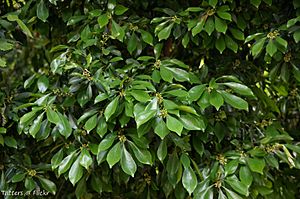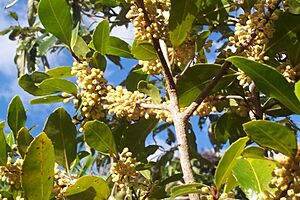Myrsine variabilis facts for kids
Quick facts for kids Myrsine variabilis |
|
|---|---|
 |
|
| Scientific classification | |
| Genus: |
Myrsine
|
| Species: |
variabilis
|
| Synonyms | |
|
|
The Muttonwood (scientific name: Myrsine variabilis) is a cool tree found in eastern Australia. It's also known as the variable muttonwood. You can find it growing from near Milton in southern New South Wales all the way up to the McIlwraith Range in far north Queensland.
This tree loves to grow on the edges of different kinds of rainforests. These include tropical, sub-tropical, warm temperate, and even rainforests right by the coast.
What the Muttonwood Looks Like
The Muttonwood is a small tree. It can grow up to about 15 meters (almost 50 feet) tall. Its trunk can be as wide as 50 centimeters (about 20 inches). People often notice it because of its thick, dark green leaves and its pretty blue fruit.
Trunk and Bark
The tree's trunk is usually straight and round. The bottom of the tree doesn't have big, wide roots sticking out. The bark is grey or brown. It feels a bit rough and corky. You might see horizontal lines and vertical cracks on it.
Leaves and Flowers
The leaves of the Muttonwood are almost directly attached to the branches. Their stalks are very short, less than 5 millimeters long. The leaves grow one after another along the stem. On young plants, the leaves have small teeth along their edges. As they get older, the edges become wavy. The leaves are quite stiff and can be shaped like a reverse spear, an oval, or an egg. They are usually 3 to 8 centimeters long. You can easily see the leaf veins on both sides of the leaf.
Cream-colored flowers grow in groups at the ends of the branches. Each flower is tiny, only about 2 millimeters long. They grow on small stalks that are about 4 millimeters long. Muttonwood trees usually flower around July and August.
Fruit and Seeds
The fruit of the Muttonwood tree ripens between November and December. These fruits are blue or violet and look like small berries. They are about 4 to 6 millimeters wide.
Birds like the Lewin's honeyeater and the rose crowned fruit dove enjoy eating these fruits. If you want to grow a Muttonwood from its seeds, it's usually quite easy. It's a good idea to remove the fleshy part around the seed (called the aril) before planting. This helps the seed sprout better.
See also
 In Spanish: Myrsine variabilis para niños
In Spanish: Myrsine variabilis para niños


